|
February 1947 Popular Science
 [Table
of Contents] [Table
of Contents]
Wax nostalgic over early technology. See articles
from
Popular Science,
published 1872 - 2021. All copyrights are hereby acknowledged.
|
I don't know what
aircraft engineers do during their lunch hour these days, but back in 1947 when
this article appeared in Popular Science magazine, some of them raced
CO2-powered model cars. They're a sort of Cub Scout
Pinewood Derby cars
on steroids. Split into light and heavy classes (7/8 ounce to 4-1/4 ounces),
these aerodynamically shaped crates were carved from balsa blocks and rolled on
metal or rubber wheels along a 240-foot string. It was the dawn of the jet age,
so building competitive jet-powered models was a natural extension of the work
many of them did as avocation / profession. I'm guessing there is more than one
Ph.D. in that crowd, but there's a good chance the guy with the fastest car was
a technician. BTW, although the venue at first glance appears to be a row of
cubicles with their occupants leaning over the walls, cubicles were not a
"thing" back in the day. Engineers and draftsmen at large firms typically sat in
huge, open rooms filled with drafting tables and test equipment.
Whizzing on Fizz
Douglas Aircraft engineers enliven noon hour by racing tiny cars jet-driven by
CO2

They're off! The squirrel-size vehicles hit speeds around 50
m.p.h. over a 240-foot straightaway in on aisle at the sprawling Santo Monica plant.
They are timed to on accuracy of 1/40 second.
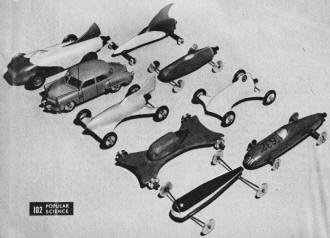
The cars are of hollow balsa, weigh from 7/8 ounce to 4 1/4 ounces.
Those under 2 1/2 ounces are in the light class - those above, in the heavy. They're
guided by strings, stopped by a curtain.
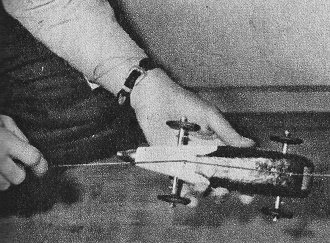
Screw eyes, bent wire, and cotter keys with an arm removed form
snap-on guides for the string that keeps the racers in line. Tool experts make the
cars.
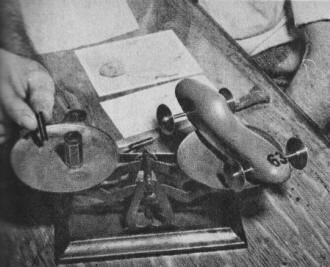
Each machine is weighed in before a race. This one balances a
one-ounce weight. The racer has thin aluminum wheels that turn on steel bushings.
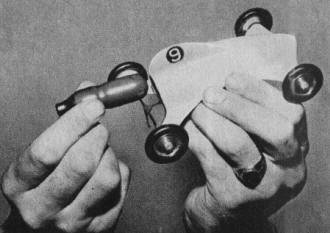
A racer's power plant - a cartridge for a soda water siphon -
is inserted into a hole drilled into its tail. This 2 1/2-ounce baby rolls on hard
rubber tires.
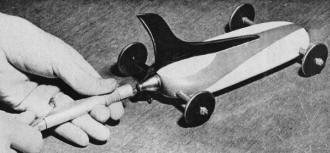
An owner awaits the "go" signal to shoot his car down the track
by puncturing its carbon-dioxide "engine" with a needle-tipped plunger. Size of
puncture in cartridge depends on car's weight.

The finish! A black job is about to crash the rolled curtain
that stops cars. Racers sometimes swerve off course and smash to pieces against
the wall.
Posted February 17, 2024
|




